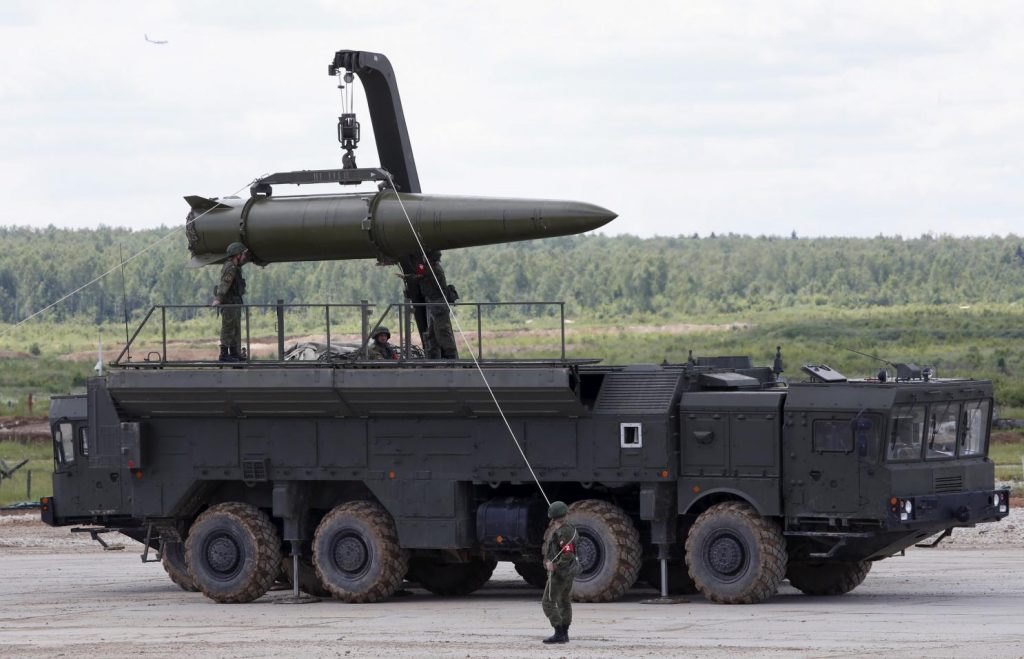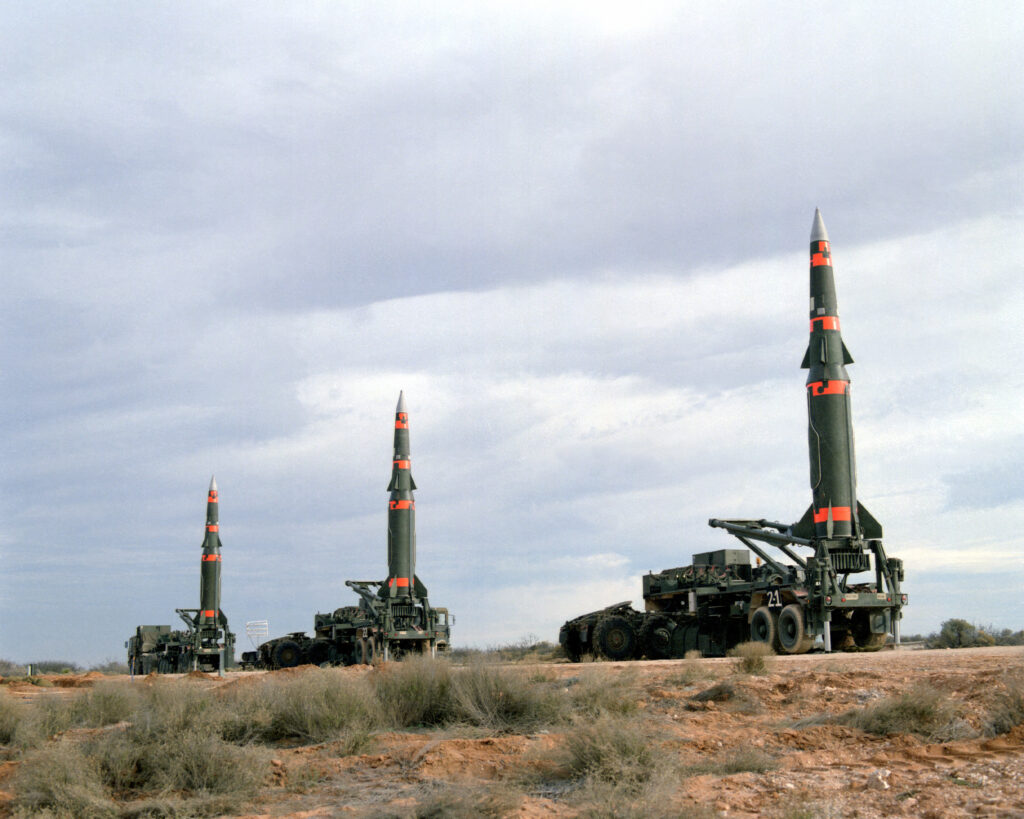The Rest Of The Story: Trump, DoD & Hill Readied INF Pullout For Years
Posted on

Russia’s 9M729 ground-based cruise missile, a key reason US considered leaving INF Treaty.
WASHINGTON: Unreleased Pentagon documents and Congressional demands for information reveal that Washington has long planned for the day when the Intermediate-range Nuclear Forces Treaty (INF) with Russia would be ripped up.
The report by the Joint Staff and Strategic Command, exclusively obtained by Breaking Defense, make clear that as far back as 2013 — a year before the Obama administration first publicly complained about Russian violations of the treaty — the Defense Department was considering which technologies the US could develop should Washington walk away from the INF.
The report points to four ways the US could quickly develop and field missiles with a range between 300 and 3,400 miles, banned under the 30 year-old treaty.
Specifically, it says that there could be:
- Modifications to existing short range or tactical weapon systems to extend range.
- Forward-based, ground-launched cruise missiles (GLCMs)
- Forward-based, ground-launched intermediate-range ballistic missiles (IRBMs)
- Forward-based, ground-launched intermediate-range missiles with trajectory shaping vehicles (TSVs).
[Click here for our full analysis of these possible new weapons]
“Without INF prohibitions,” the report said, the United States could develop ground-launched systems “capable of using any trajectory (ballistic, shaped, or non-ballistic). This would result in systems with the required timeliness, effects on target, and survivability needed to close the existing capability gap.”
The restrictions in the treaty, written in 1987, don’t account for new advances in hypersonic boost-glide missiles. But “without INF, the key benefit would be the ability to field a ground-launched ballistic system, such as an IRBM with a TSV,” the report said. “This type of system could deliver the same or better capability as a boost-glide vehicle, with potentially less technological risk and cost.”
Looking Beyond INF
For months, Pentagon officials have publicly signaled they were considering a post-INF landscape. David Trachtenberg, deputy undersecretary of Defense for policy, told the Senate Foreign Relations Committee last month that, given Russia’s years-long violations, the Trump administration is “focused on preparing the United States for a world without the INF Treaty.”
U.S. lawmakers have long taken an interest. The Hill is still waiting for an overdue report from the Pentagon mandated in the 2018 defense authorization bill that would lay out options for developing systems that would fill the capabilities gaps that have grown between the US and Russia and China. In April, the Pentagon’s chief weapons buyer Ellen Lord sent a letter to the heads of the defense committees asking for more time, saying the department was in the “early stages” of assessing cost, requirements and what systems might be best suited to fit the bill. It was unclear, she explained, what “existing missile systems could be modified for such a role.”
Pentagon spokesperson Lt. Col. Michelle Baldanza confirmed to me today that the department continues to work on “a review of U.S. options for conventional, ground-launched, intermediate-range missile systems, which would enable the United States to defend ourselves and our allies, should Russia fail to return to compliance.”
It is not clear if the report was ever delivered to lawmakers.

Left to right: Jim Mattis (US Secretary of Defense) with NATO Secretary General Jens Stoltenberg and Ambassador Kay Bailey Hutchison (US Permanent Representative to NATO)
Defense Secretary Jim Mattis and U.S. Ambassador to NATO Kay Bailey Hutchison also slammed Russian violations of the pact during an alliance meeting in Brussels last month, with Hutchison warning the US might be forced to “take out a missile” that could hit NATO territory. Following an uproar over her comments, Hutchison later clarified in a Tweet, “I was not talking about preemptively striking Russia,” but Moscow “needs to return to INF Treaty compliance or we will need to match its capabilities to protect US & NATO interests.”
But the focus on Russia is only part of the equation.
China’s missile stockpiles have been a giant flashing red light to defense officials for years, and they estimate at least 90 percent of Beijing’s arsenal occupies the treaty’s 300 to 3,400 mile restriction. China, of course, is not a party to the INF Treaty, something which concerns both Washington and Moscow.
The China Factor
The Chinese ground-based missile capabilities means the United States has to “pay a power projection tax” in Asia to launch conventional cruise missiles from expensive aircraft, ships and submarines, rather than fire them from ashore from mobile ground-launchers, said Eric Sayers, senior adjunct fellow at the Center for a New American Security and former advisor to the commander of Pacific Command. “This ties limited air and maritime forces down and drags them away from other critical missions like anti-submarine and anti-air warfare.”
The Trump Administration has classified both Russia and China as “revisionist powers” that pose the most significant strategic threat to the United States today.
The Trump administration is in the early stages of what promises to be a bruising trade war with China that touches on everything from cars to agricultural products. The Pentagon and White House also recently released an exhaustive Defense Industrial Base report that raises red flags over Chinese predatory trade practices and its stranglehold over several rare earths markets critical of the US defense industry.
Earlier today, two US warships transited the Taiwan Strait in a clear signal to China that the United States would maintain its presence in the region, despite the rapidly growing — and modernizing — Chinese military.
“USS Curtis Wilbur and USS Antietam conducted a routine Taiwan Strait Transit on October 22, in accordance with international law,” Cmdr. Nate Christensen, a spokesman for US Pacific Fleet, told CNN.
A Self-Inflicted Wound?
Russian violations of the INF treaty have effectively killed the document critics argue, as Russia continues to deny the charges while seeking to include armed US drones as part of the agreement, which the US rejects.
Despite those tensions, there is a sense in Washington that the Trump administration scored an own goal in its handling of the announcement. It apparently didn’t alert allies about the final decision.
“The overwhelming view of people, not only in the United States and Russia but around the world, will be that it was the United States that killed this treaty,” said Richard Burt, former U.S. chief negotiator of the Strategic Arms Reduction Treaty, on a conference call with reporters. “The handling of this decision is just simply god awful.”
Thomas Countryman, former assistant secretary of State for international security and nonproliferation, told me the failure to even attempt to pull China and Russia into a larger deal was, “absolutely a missed opportunity” and has only handed Moscow “the double-victory it sought: keeping a new system that adds to its military strength, while being able to shame/blame the US for accelerating an arms race.”
As far as China is concerned, “It would be stabilizing for global security if a global INF treaty could be achieved. But US withdrawal will simply make even harder what would have been, in any case, an extremely difficult negotiation with China and others.”
Subscribe to our newsletter
Promotions, new products and sales. Directly to your inbox.


